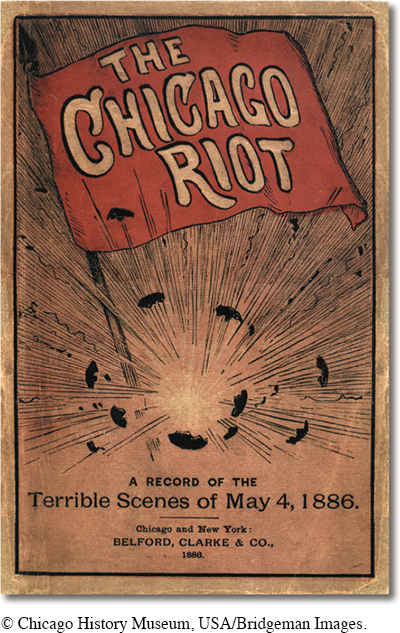The American Promise: Printed Page 543
The American Promise, Value Edition: Printed Page 500
The American Promise: A Concise History: Printed Page 567
Haymarket and the Specter of Labor Radicalism
While the AFL and the Knights of Labor competed for members, more radical labor groups, including socialists and anarchists, believed that reform was futile and called instead for social revolution. Both the socialists and the anarchists, sensitive to criticism that they preferred revolution in theory to improvements here and now, rallied around the popular issue of the eight-
Since the 1840s, labor had sought to end the twelve-
The American Promise: Printed Page 543
The American Promise, Value Edition: Printed Page 500
The American Promise: A Concise History: Printed Page 567
Page 546All factions of the labor movement came together in Chicago on May Day. A group of labor radicals led by anarchist Albert Parsons, a Mayflower descendant, and August Spies, a German socialist, spearheaded the eight-
The cautious labor leaders in their frock coats and starched shirts stood in sharp contrast to the dispossessed workers out on strike across town at Chicago’s huge McCormick reaper works. There strikers watched helplessly as the company brought in strikebreakers to take their jobs and marched the “scabs” to work under the protection of the Chicago police and security guards supplied by the Pinkerton Detective Agency. Cyrus McCormick Jr., son of the inventor of the mechanical reaper, viewed labor organization as a threat to his power as well as to his profits; he was determined to smash the union.
During the May Day rally, 45,000 workers paraded peacefully down Michigan Avenue in support of the eight-
We want to feel the sunshine;
We want to smell the flowers,
We’re sure that God has willed it,
And we mean to have eight hours.
Eight hours for work, eight hours for rest,
Eight hours for what we will!

Trouble came two days later, when strikers attacked strikebreakers outside the McCormick works and police opened fire, killing or wounding six men. Angry radicals urged workers to “arm yourselves and appear in full force” at a rally in Haymarket Square.
On the evening of May 4, the turnout at Haymarket was disappointing. No more than two or three thousand gathered in the drizzle to hear Spies, Parsons, and the other speakers. Mayor Carter Harrison, known as a friend of labor, mingled conspicuously in the crowd, pronounced the meeting peaceable, and went home to bed. Sometime later, police captain John “Blackjack” Bonfield marched his men into the crowd, by now fewer than three hundred people, and demanded that it disperse. Suddenly, someone threw a bomb into the police ranks. After a moment of stunned silence, the police drew their revolvers. “Fire and kill all you can,” shouted a police lieutenant. When the melee ended, seven policemen and an unknown number of others lay dead. An additional sixty policemen and thirty or forty civilians suffered injuries.
News of the “Haymarket riot” provoked a nationwide convulsion of fear, followed by blind rage directed at anarchists, labor unions, strikers, immigrants, and the working class in general. Eight men, including Parsons and Spies, went on trial in Chicago. “Convict these men,” thundered the state’s attorney, Julius S. Grinnell, “make examples of them, hang them, and you save our institutions.” Although the state could not link any of the defendants to the Haymarket bombing, the jury nevertheless found them all guilty. Four men were hanged, one committed suicide, and three received prison sentences.
The American Promise: Printed Page 543
The American Promise, Value Edition: Printed Page 500
The American Promise: A Concise History: Printed Page 567
Page 547The bomb blast at Haymarket had lasting repercussions. To commemorate the death of the Haymarket martyrs, labor made May 1 an annual international celebration of the worker. But the Haymarket bomb, in the eyes of one observer, proved “a godsend to all enemies of the labor movement.” It effectively scotched the eight-
REVIEW Why did membership in the Knights of Labor rise in the late 1870s and decline in the 1890s?